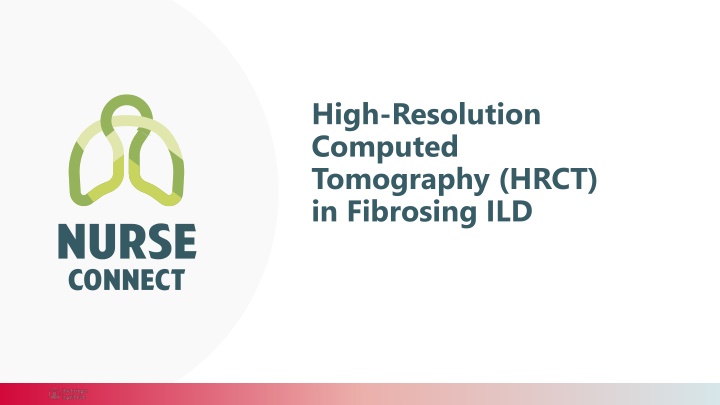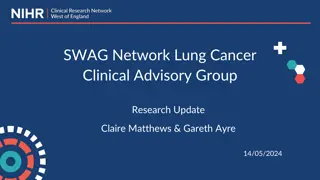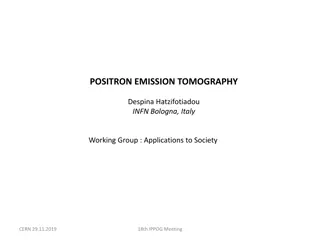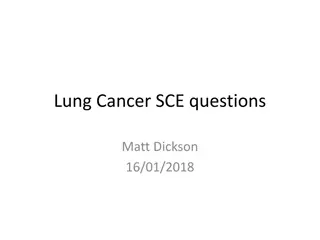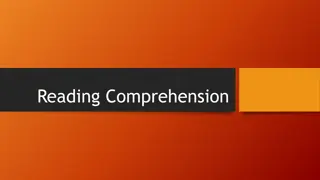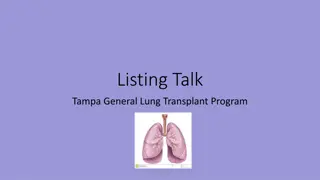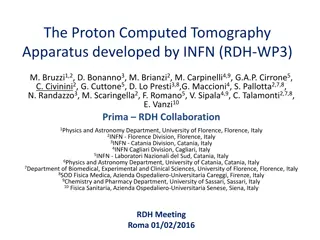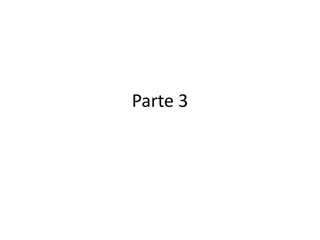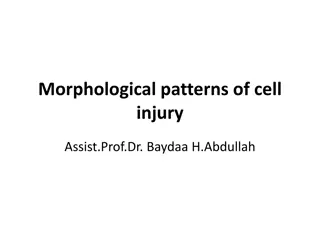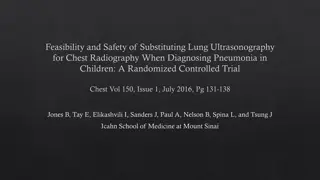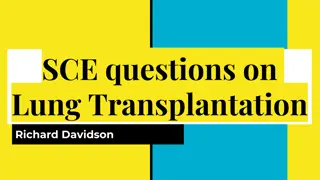Role of High-Resolution Computed Tomography in Fibrosing Interstitial Lung Diseases
HRCT plays a crucial role in diagnosing and monitoring fibrosing interstitial lung diseases (ILDs). It helps identify abnormalities not visible on X-rays, leading to early, accurate diagnoses and potentially avoiding invasive procedures. HRCT assists in distinguishing specific ILDs based on radiographic patterns and can even alter initial diagnoses. A systematic analysis of HRCT scans aids in narrowing down ILD differential diagnoses by assessing fibrotic patterns and features. Understanding inflammatory and non-inflammatory pathways in ILDs is crucial for recognizing different radiological patterns of fibrosis like UIP and NSIP. The presence of fibroblastic foci, honeycombing, and abnormal wound repair can impact prognosis and mortality risk in ILDs.
Download Presentation

Please find below an Image/Link to download the presentation.
The content on the website is provided AS IS for your information and personal use only. It may not be sold, licensed, or shared on other websites without obtaining consent from the author.If you encounter any issues during the download, it is possible that the publisher has removed the file from their server.
You are allowed to download the files provided on this website for personal or commercial use, subject to the condition that they are used lawfully. All files are the property of their respective owners.
The content on the website is provided AS IS for your information and personal use only. It may not be sold, licensed, or shared on other websites without obtaining consent from the author.
E N D
Presentation Transcript
High-Resolution Computed Tomography (HRCT) in Fibrosing ILD
HRCT plays a crucial role in the diagnosis and monitoring of fibrosing interstitial lung diseases (ILDs)1-4 HRCT allows for the recognition of abnormalities, which may not be apparent on chest X-rays may lead to earlier and more accurate ILD diagnoses may preclude the need for invasive diagnostic and/or prognostic techniques in CTD-ILD if a confident ILD diagnosis can be made with HRCT and other minimally invasive tests6* may be used to identify sites for BAL and lung biopsy if needed The pattern of radiographic abnormalities on HRCT in the context of clinical findings can help to identify specific ILDs HRCT data may even change the clinician s first-choice diagnosis in half of the cases5 *BAL or biopsy may especially still be of additional diagnostic value in patients with a sensitizing antigen and in patients with an HRCT pattern that is consistent with a non-IPF diagnosis. BAL is not recommended in CTD-ILD because the additional value of BAL to HRCT is unclear.6 HRCT=High-Resolution Computed Tomography; CTD=Connective Tissue Disease; BAL=Bronchoalveolar Lavage; IPF=Idiopathic Pulmonary Fibrosis; 1. Wijsenbeek M, Cottin V. Spectrum of Fibrotic Lung Diseases. N Engl J Med. 2020;383(10):958-68; 2. Cosgrove GP, Bianchi P, Danese S, et al. Barriers to timely diagnosis of interstitial lung disease in the real world: the INTENSITY survey. BMC Pulm Med. 2018;18(1):9; 3. Sverzellati N. Highlights of HRCT imaging in IPF. Respir Res. 2013;14 Suppl 1(Suppl 1):S3; 4. Walsh SL, Devaraj A, Enghelmayer JI, et al. Role of imaging in progressive-fibrosing interstitial lung diseases. European Respiratory Review. 2018;27(150):180073; 5. Walsh SLF, Maher TM, Kolb M, et al. Diagnostic accuracy of a clinical diagnosis of idiopathic pulmonary fibrosis: an international case-cohort study. Eur Respir J. 2017;50(2):170002; 6. Adams TN, Batra K, Silhan L, et al. Utility of bronchoalveolar lavage and transbronchial biopsy in patients with interstitial lung disease. Lung. 2020;198(5):803-10.
A systematic analysis of HRCT scans narrows down the differential diagnosis of ILD1 Is the HRCT normal or abnormal? ILD Normal Abnormal Interstitial are there features of a fibrosing lung disease? F-ILD diagnosis Define fibrotic pattern to aid F-ILD diagnosis F-ILD=Fibrosing ILD; 1. Jacob J, Hansell DM. HRCT of fibrosing lung disease. Respirology. 2015;20(6):859-72.
Inflammatory and non-inflammatory pathways may lead to different radiological patterns of fibrosis in ILD1,2 Accelerated epithelial aging A UIP pattern is associated with disease progression and poor prognosis4,5 UIP Fibroblastic foci and microscopic honeycombing Aberrant wound repair Repeated injury Patients with a CT pattern of UIP have an increased risk of mortality4,5 NSIP, cHP Inflammatory trigger Chronic interstitial inflammation Interstitial fibrosis NSIP and UIP may coexist in individual patients with IIP3 NSIP=Non-Specific Interstitial Pneumonia; cHP=chronic Hypersensitivity Pneumonitis; UIP=Usual Interstitial Pneumonitis; IIP=Idiopathic Interstitial Pneumonia; 1. Noble PW. Epithelial fibroblast triggering and interactions in pulmonary fibrosis. Eur Respir Rev 2008;17:123-29; 2. Belloli EA, Beckford R, Hadley R, et al. Idiopathic non-specific interstitial pneumonia. Respirology. 2016;21(2):259-68; 3. Adegunsoye A, Oldham JM, Valenzi E, et al. Interstitial Pneumonia With Autoimmune Features: Value of Histopathology. Arch Pathol Lab Med. 2017;141(7):960-9.; 4. Chan C, Ryerson CJ, Dunne JV, et al. Demographic and clinical predictors of progression and mortality in connective tissue disease-associated interstitial lung disease: a retrospective cohort study. BMC Pulm Med 2019;19(1):192; 5. Kolb M, Va kov M. The natural history of progressive fibrosing interstitial lung diseases. Respir Res. 2019;20(1):57.
Idiopathic pulmonary fibrosis (IPF) is characterized by radiological and histological features of UIP1 The hallmark of pulmonary fibrosis IPF is characterized by a UIP pattern which is believed to result from repeated epithelial injury, activation and/or apoptosis with abnormal wound healing2 A UIP pattern can also occur in other fibrosing ILDs, such as fibrotic hypersensitivity pneumonitis, ILD associated with rheumatoid arthritis or other connective tissue diseases, or exposure-related ILDs1,3 A UIP pattern is associated with worse prognosis3,4 1. Raghu G, Remy-Jardin M, Richeldi L, et al. Idiopathic Pulmonary Fibrosis (an Update) and Progressive Pulmonary Fibrosis in Adults: An Official ATS/ERS/JRS/ALAT Clinical Practice Guideline. Am J Respir Crit Care Med. 2022;205(9):e18-e47; 2. Noble PW. Epithelial fibroblast triggering and interactions in pulmonary fibrosis. European Respiratory Review. 2008;17:123-9; 3. Kolb M, Va kov M. The natural history of progressive fibrosing interstitial lung diseases. Respir Res. 2019;20(1):57; 4. Chan C, Ryerson CJ, Dunne JV, et al. Demographic and clinical predictors of progression and mortality in connective tissue disease-associated interstitial lung disease: a retrospective cohort study. BMC Pulm Med 2019;19(1):192.
A SYSTEMATIC APPROACH TO IDENTIFY HRCT PATTERNS
To identify HRCT patterns, a systematic approach is required1,2 A radiologist will 2 Determine distribution and extent Evaluate image quality Assess specific disease features This allows for classification into four categories also known as the Raghu criteria: UIP, probable UIP, indeterminate for UIP, or alternative diagnosis2,3 1. Jacob J, Hansell DM. HRCT of fibrosing lung disease. Respirology. 2015;20(6):859-72; 2. Lynch DA, Sverzellati N, Travis WD, et al. Diagnostic criteria for idiopathic pulmonary fibrosis: a Fleischner Society White Paper. Lancet Respir Med. 2018;6(2):138-53; 3. Raghu G, Remy-Jardin M, Myers JL, et al. Diagnosis of Idiopathic Pulmonary Fibrosis. An Official ATS/ERS/JRS/ALAT Clinical Practice Guideline. Am J Respir Crit Care Med. 2018;198(5):e44-e68.
For accurate ILD diagnosis CT images should be of high quality Necessary conditions: Thin sections ( 1.5 mm) and high spatial resolution construction are required for optimal CT quality1,2 Full inspiration is needed, as inadequate inspiration can lead to a misinterpretation of findings Expiratory scans can identify air trapping, a feature that commonly occurs in hypersensitivity pneumonitis2 Additional conditions: A maximum intensity projection reconstruction (MIP) optimizes the detection of (micro)nodules1 A minimum intensity projection reconstruction (minIP) optimizes the detection of subtle hypo-attenuated lesions including cysts or bronchiectasis1 For monitoring of fibrosing ILDs, follow-up with HRCT is indicated when there is clinical suspicion of worsening fibrosis3; radiation dose therefore needs minimizing according to ALARA principles (As Low As Reasonably Achievable)4 1. Raghu G, Remy-Jardin M, Myers JL, et al. Diagnosis of Idiopathic Pulmonary Fibrosis. An Official ATS/ERS/JRS/ALAT Clinical Practice Guideline. Am J Respir Crit Care Med. 2018;198(5):e44-e68; 2. Lynch DA, Sverzellati N, Travis WD, et al. Diagnostic criteria for idiopathic pulmonary fibrosis: a Fleischner Society White Paper. Lancet Respir Med. 2018;6(2):138-53; 3. Raghu G, Remy-Jardin M, Richeldi L, et al. Idiopathic pulmonary fibrosis (an update) and progressive pulmonary fibrosis in adults: An official ATS/ERS/JRS/ALAT clinical practice guideline. Am J Respir Crit Care Med. 2022;205(9):e18-e47; 4. Sergiacomi G, et al. High-resolution computed tomography and magnetic resonance imaging protocols in the diagnosis of fibrotic interstitial lung disease: Overview for non-radiologists . Sarcoidosis Vasc Diffuse Lung Dis 2017;34(4):300- 306.
HRCT pattern recognition: assessing disease features Increased attenuation Decreased attenuation Nodules Mosaic perfusion Ground-glass Cystic pattern Reticular pattern Consolidation Crazy paving Random Perilymphatic Centrilobular Interlobular septa Intralobular lines Air trapping No air trapping Airways disease Vascular disease Tree-in-bud Non-tree-in-bud Hypersensitivity pneumonitis Infection Respiratory bronchiolitis Follicular bronchiolitis Lymphocytic interstitial pneumonia (LIP) Metastases Miliary tuberculosis Sarcoidosis Carcinomatous lymphangitis Pneumocon- iosis Lymphocytic interstitial pneumonia (LIP) Infectious bronchiolitis Edema Hemorrhage Hypersensitivity pneumonitis Infection Nonspecific interstitial pneumonia (NSIP) Desquamative interstitial pneumonia (DIP) Edema Hemorrhage Infection Alveolar proteinosis Bronchiolo- alveolar carcinoma (BAC) Edema Carcinomatous lymphangitis Lymphocytic interstitial pneumonia (LIP) Fibrosis Idiopathic pulmonary fibrosis (IPF) Usual interstitial pneumonia (UIP) Nonspecific interstitial pneumonia (NSIP) Chronic hypersensitivity pneumonitis (cHP) Lobar pneumonia Eosinophilic pneumonia Organizing pneumonia (OP) Malignancy Lymphangio- leiomyomatosis (LAM) Langerhans cell histiocytosis Lymphocytic interstitial pneumonia (LIP) Emphysema Cystic bronchiectasis Honeycombing Obliterative bronchiolitis Cystic fibrosis Hypersensitivity pneumonitis Bronchiectasis Asthma Chronic pulmonary embolism Adapted from a poster created in 2021 in collaboration with Fredrik Ahlfors, radiologist and ILD expert Telemedicine Clinic.
Reticulations Reticular abnormalities are small linear opacities caused by thickened interlobular or intralobular septa (lines)1 Intralobular reticular abnormalities may be a sign of a fibrosing lung disease, but is in itself no proof of fibrosis1 HRCT abnormalities may have a broad differential diagnosis and should thus, always be evaluated with other HRCT and clinical findings1 Intralobular reticulations Marked intralobular reticulations (without honeycombing) in a patient with NSIP associated with systemic sclerosis 1. Jacob J, Hansell DM. HRCT of fibrosing lung disease. Respirology. 2015;20(6):859-72.
Traction bronchiectasis and bronchiolectasis Traction bronchiectasis can be associated with fibrosis Traction bronchiectasis and bronchiolectasis are characterized by irregular bronchial and bronchiolar dilatation Fibrosis results in loss of volume and mechanical traction, leading to enlarged bronchi and bronchioles It is predominantly seen in the periphery of the lungs, where bronchi are prone to retraction and distortion because they contain less supportive cartilage1 Traction bronchiolectasis Traction bronchiectasis Traction bronchiectasis and bronchiolectasis in a patient with usual interstitial pneumonia (UIP) 1. Jacob J, Hansell DM. HRCT of fibrosing lung disease. Respirology. 2015;20(6):859-72.
Honeycombing Honeycombing is definite proof of fibrosis1,2 Honeycombing is characterized by clustered, thick- walled cystic spaces with well-defined borders They generally measure between 3 and 5 mm in diameter, but sometimes they can measure up to 25 mm in size A single subpleural layer of two or three contiguous cysts can be present, but in advanced fibrotic disease, several stacked layers may occur2 Honeycombing Traction bronchiectasis Intralobular reticulations of the lower sections Subpleural honeycombing in a patient with usual interstitial pneumonia (UIP) 1. Jacob J, Hansell DM. HRCT of fibrosing lung disease. Respirology. 2015;20(6):859-72; 2. Lynch DA, Sverzellati N, Travis WD, et al. Diagnostic criteria for idiopathic pulmonary fibrosis: a Fleischner Society White Paper. Lancet Respir Med. 2018;6(2):138-53.
Ground-glass opacity (GGO) GGO may be a sign of a fibrosing lung disease, but in itself is no proof of fibrosis1 GGO is characterized by slightly increased attenuation of lung parenchyma (grey or hazy on HRCT)2 Vessels and structures can still be distinguished GGO due to fibrosis is often seen as very fine fibrosis; it may have a granular appearance if it occurs together with a coarse reticular pattern and traction bronchiectasis2 GGO can also be caused by other pathologies, such as infections, exacerbations, hemorrhage and pulmonary edema3 Intralobular reticulations Traction bronchiolectasis Ground-glass opacity associated with intralobular reticulations and traction bronchiolectasis in a patient with NSIP associated with systemic sclerosis Other HRCT and clinical findings are helpful in the differential diagnosis of ILD3,4 1. Jacob J, Hansell DM. HRCT of fibrosing lung disease. Respirology. 2015;20(6):859-72; 2. Collins J, et al. AJR Am J Roentgenol. 1997;169(2):355-67; 3. Cozzi D, Cavigli E, Moroni C, et al. Ground-glass opacity (GGO): a review of the differential diagnosis in the era of COVID-19. Jpn J Radiol. 2021;39(8):721-32; 4. Battista G, Sassi C, Zompatori M, et al. Ground-glass opacity: interpretation of high resolution CT findings. Radiol Med. 2003;106(5-6):425-44.
Consolidation Consolidation may occur in fibrosing lung disease, but is no proof of fibrosis Consolidation is characterized by such high (homogenous) attenuation that vessels and other structures can no longer be distinguished1,2 Differential diagnoses of GGO and consolidation overlap greatly and include hemmorhage, malignancies or inflammatory pathologies, such as pneumonia, sarcoidosis and infections3 Bilateral subpleural alveolar consolidation with air bronchogram in a patient with chronic cough (organizing pneumonia) 1. Collins J, Stern EJ. Ground-glass opacity at CT: the ABCs. AJR Am J Roentgenol. 1997;169(2):355-67; 2. Hansell DM, Bankier AA, MacMahon H, et al. Fleischner Society: Glossary of Terms for Thoracic Imaging. Radiology. 2008;246(3):697-722; 3. Elicker B, Pereira CA, Webb R, et al. High-resolution computed tomography patterns of diffuse interstitial lung disease with clinical and pathological correlation. J Bras Pneumol. 2008;34(9):715-44.
Nodules and cysts Nodules and cysts may occur in (fibrosing) lung disease, but are no proof of fibrosis Nodules are rounded opacities up to 3 cm in diameter. They can be well or poorly defined1 The causes of cavitary nodules range from acute to chronic infections, chronic systemic diseases and malignancies2 Nodules Cavitary nodules Cysts Cysts Cysts are well-defined rounded lucent areas with variable, thin walls (<2 mm)1 Nodules and cysts in a patient with Langerhans cell histiocytosis Multiple thin-walled cysts and bilateral ground-glass opacities in a patient with lymphoid interstitial pneumonia associated with Sj gren s disease 1. Hansell DM, Bankier AA, MacMahon H, et al. Fleischner Society: Glossary of Terms for Thoracic Imaging. Radiology. 2008;246(3):697-722; 2. Parkar AP, Kandiah P. Differential diagnosis of cavitary lung lesions. J Belg Soc Radiol. 2016;100(1):100.
Mosaic attenuation and air trapping Mosaic attenuation and air trapping may occur in (fibrotic) lung disease, but are no proof of fibrosis Alternating regions with decreased, normal or increased attenuation can cause a patchy mosaic pattern1 Mosaic attenuation with air trapping and ground-glass opacities in a patient with (subacute) hypersensitivity pneumonitis A mosaic pattern can occur in the presence of air trapping producing focal zones of decreased attenuation, but can, for example, also occur due to ground-glass opacity1 Ground-glass opacity Clear lobule Lobule with air trapping Air trapping reflects retention of air in the lung distal to an obstruction, and can be seen on end- expiration scans and pulmonary function tests1,2 1. Hansell DM, Bankier AA, MacMahon H, et al. Fleischner Society: Glossary of Terms for Thoracic Imaging. Radiology. 2008;246(3):697-722; 2. Al-Ashkar F, Mehra R, Mazzone PJ. Interpreting pulmonary function tests: recognize the pattern, and the diagnosis will follow. Cleve Clin J Med. 2003;70(10):866.
Key signs of fibrosis are honeycombing, traction bronchiectasis and volume loss1 Loss of lung volume in itself is of limited diagnostic value In cases where honeycombing is absent and traction bronchiectasis is ambiguous, volume loss can be a valuable indicator of fibrosis1 Loss of volume can be inferred from the position of the oblique fissures:1 Lower lobe volume loss shift to more posterior Upper lobe volume loss elevated above the aortic arch at its superior aspect Movement of the fissure to posterior indicates volume loss No volume loss Courtesy of Dr. Helmut Prosch 1. Jacob J, Hansell DM. HRCT of fibrosing lung disease. Respirology. 2015;20:859-72.
CATEGORIZING HRCT PATTERNS Raghu criteria
For prognosis and treatment it is important to know whether a fibrotic ILD shows a (probable) UIP pattern or a pattern associated with an alternative diagnosis There are four categories of fibrotic patterns:1,2 UIP Probable UIP Indeterminate for UIP Alternative diagnosis Subpleural and basal distribution Comparable to UIP except that honeycombing is absent Distribution of fibrotic characteristics variable or diffuse, without subpleural predominance Distribution may be more upper or mid-lung, or peribronchovascular with subpleural sparing Often heterogeneous, occassionally diffuse, may be assymetric Absence of subpleural sparing not-fitting an alternative diagnosis Extensive ground-glass, nodules or consolidations, mosaic attenuation and air trapping may be present Honeycombing with or without traction bronchiectasis/ bronchiolectasis Irregular thickening of interlobular septa Many HRCT findings may be classified as indeterminate for UIP or are suggestive of an alternative diagnosis Usually superimposed with a reticular pattern, mild GGO 1. Raghu G, Remy-Jardin M, Richeldi L, et al. Idiopathic Pulmonary Fibrosis (an Update) and Progressive Pulmonary Fibrosis in Adults: An Official ATS/ERS/JRS/ALAT Clinical Practice Guideline. Am J Respir Crit Care Med. 2022;205(9):e18-e47; 2. Lynch DA, Sverzellati N, Travis WD, et al. Diagnostic criteria for idiopathic pulmonary fibrosis: a Fleischner Society White Paper. Lancet Respir Med. 2018;6(2):138-53.
HRCT findings, combined with histopathology findings, narrow down the differential diagnosis of fibrotic ILDs1 Histopathology pattern IPF suspected* Indeterminate for UIP or biopsy not performed Alternative diagnosis UIP Probable UIP UIP IPF IPF IPF Non-IPF dx Probable UIP IPF IPF Non-IPF dx IPF (Likely) HRCT Pattern IPF IPF (Likely) Indeterminate Non-IPF dx Indeterminate Alternative diagnosis Non-IPF dx IPF (Likely) Indeterminate Non-IPF dx * Clinically suspected of having IPF is defined as unexplained patterns of bilateral pulmonary fibrosis on chest radiography or chest computed tomography, bibasilar inspiratory crackles, and age >60 years. Diagnostic confidence may need to be downgraded if histopathological assessment is based on transbronchial lung cryobiopsy given the smaller biopsy size and greater potential for sampling error compared with surgical lung biopsy. IPF is the likely diagnosis when any of the following features are present: 1) moderate to severe traction bronchiectasis and/or bronchiolectasis (defined as mild traction bronchiectasis and/or bronchiolectasis in four or more lobes, including the lingula as a lobe, or moderate to severe traction bronchiectasis in two or more lobes) in a man >50 years old or in a woman >60 yr old, 2) extensive (>30%) reticulation on HRCT and age >70 yr, 3) increased neutrophils and/or absence of lymphocytosis in BAL fluid, and 4) multidisciplinary discussion produces a confident diagnosis of IPF. Indeterminate for IPF 1) without an adequate biopsy remains indeterminate and 2) with an adequate biopsy may be reclassified to a more specific diagnosis after multidisciplinary discussion and/or additional consultation; Dx=diagnosis; 1. Raghu G, Remy-Jardin M, Richeldi L, et al. Idiopathic Pulmonary Fibrosis (an Update) and Progressive Pulmonary Fibrosis in Adults: An Official ATS/ERS/JRS/ALAT Clinical Practice Guideline. Am J Respir Crit Care Med. 2022;205(9):e18-e47.
Diagnostic algorithm for IPF1 Patient suspected of having IPF Potential cause/associated condition NO YES Chest HRCT pattern Confirmation of specific diagnosis (including with HRCT) NO Indeterminate for UIP of alternative diagnosis UIP or probable UIP* MDD YES BAL TBLC SLB MDD IPF Alternative diagnosis *Patients with a radiological pattern of probable usual interstitial pneumonia (UIP) can receive a diagnosis of IPF after multidisciplinary discussion (MDD) without confirmation by lung biopsy in the appropriate clinical setting (e.g., 60 yr old, male, smoker); BAL may be performed before MDD in some patients evaluated in experienced centers. Transbronchial lung cryobiopsy (TBLC) may be preferred to surgical lung biopsy (SLB) in centers with appropriate expertise and/or in some patient populations. A subsequent SLB may be justified in some patients with nondiagnostic findings on TBLC; 1. Raghu G, Remy-Jardin M, Richeldi L, et al. Idiopathic Pulmonary Fibrosis (an Update) and Progressive Pulmonary Fibrosis in Adults: An Official ATS/ERS/JRS/ALAT Clinical Practice Guideline. Am J Respir Crit Care Med. 2022;205(9):e18-e47.
The distribution of HRCT findings identifies the radiological pattern1,2 Usual interstitial pneumonia (UIP) Non-specific interstitial pneumonia (NSIP) Fibrotic hypersensitivity pneumonia (fHP) Fibrotic granulomatous diseases Basal and subpleural predominance Distribution often heterogeneous Basal and subpleural predominance Subpleural sparing Distribution usually homogeneous Random both axially and craniocaudally Or Mid lung zone-predominant Upper lobe and peribronchovascular predominance Courtesy of Dr. Helmut Prosch 1. Jacob J, Hansell DM. HRCT of fibrosing lung disease. Respirology. 2015;20(6):859-72; 2. Lynch DA, Sverzellati N, Travis WD, et al. Diagnostic criteria for idiopathic pulmonary fibrosis: a Fleischner Society White Paper. Lancet Respir Med. 2018;6(2):138-53.
HRCT-patterns in different fibrosing ILDs1 Diagnosis Fibrotic pattern on HRCT iNSIP iNSIP patients have NSIP pattern on HRCT, which can be either cellular or fibrotic IPF Both the histological and radiological pattern in IPF is UIP. Patients with UIP/IPF may also have features of PPFE* apically HRCT findings are often unspecific or inconsistent with other defined patterns and clinical and pathological findings. Up to half of patients, however have features of UIP Unclassifiable IIP Fibrotic (chronic) hypersensitivity pneumonitis Ground-glass, traction bronchiectasis, mosaic pattern with air trapping and occasional, limited honeycombing Sarcoidosis stage IV Perilymphatic, patchy distribution of nodules, traction bronchiectasis, irregular lines and cysts RA-ILD UIP pattern is the most common, of which some patients develop a progressive disease course, NSIP is less frequent SSc-ILD NSIP is the dominant HRCT pattern, but about a third of patients will also develop a UIP pattern *Pleuroparenchymal fibroelastosis (PPFE) is categorized as a rare idiopathic interstitial pneumonia, which involves a combination of fibrosis in the visceral pleura and fibroelastotic changes that are predominantly seen in the subpleural lung parenchyma.2 iNSIP=Idiopathic Non-specific Interstitial Pneumonia; RA=Rheumatoid Arthritis; SSc=Systemic Sclerosis; 1. Adapted from a poster created in 2021 in collaboration with Fredrik Ahlfors, radiologist and ILD expert Telemedicine Clinic; 2. Chua F, Desai SR, Nicholson AG, et al. Pleuroparenchymal Fibroelastosis. A Review of clinical, radiological, and pathological characteristics. Ann Am Thorac Soc. 2019;16(11):1351-59.
Key messages Inflammatory and non-inflammatory pathways may lead to different radiological patterns of fibrosis in ILD1,2 A systematic approach to analyse HRCT patterns can narrow down the differential diagnosis of ILD3 HRCT is also important to predict and detect progression3,4 A Usual Interstitial Pneumonia (UIP) pattern is associated with disease progression and poor prognosis5,6 1. Noble PW. Epithelial fibroblast triggering and interactions in pulmonary fibrosis. Eur Respir Rev 2008;17:123-29; 2. Belloli EA, Beckford R, Hadley R, et al. Idiopathic non-specific interstitial pneumonia. Respirology. 2016;21(2):259-68; 3. Sverzellati N. Highlights of HRCT imaging in IPF. Respir Res. 2013;14 Suppl 1(Suppl 1):S3; 4. Walsh SL, Devaraj A, Enghelmayer JI, et al. Role of imaging in progressive-fibrosing interstitial lung diseases. European Respiratory Review. 2018;27(150):180073. 5. Chan C, Ryerson CJ, Dunne JV, et al. Demographic and clinical predictors of progression and mortality in connective tissue disease-associated interstitial lung disease: a retrospective cohort study. BMC Pulm Med 2019;19(1):192; 6. Kolb M, Va kov M. The natural history of progressive fibrosing interstitial lung diseases. Respir Res. 2019;20(1):57. PC-MID-101909
